Controls on the Layers rollout allow you to add layers of animation above the original biped animation. This is a powerful way to apply global changes to character animation.
For example, if you add a layer to a run cycle and rotate the spine forward at any frame, the animation becomes a crouching run. The original biped motion is kept intact and can be viewed by switching back to the original layer. You can view layers individually or as a composite of animation in all layers. Layers behave like freeform animation; the biped can adopt any position.
With layers, you can easily adjust raw motion-capture data that contains keys at every frame. Simply add a layer and keyframe the biped. The original layer is displayed as red bones.
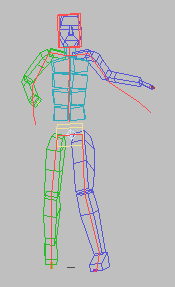
Honoring IK Constraints Across Layers
You can maintain a biped's IK constraints across layers by retargeting its hands and feet to the original layer. This assures that the biped's constrained body parts are honored and locked in place while you make animation changes on the upper layers.
You can also choose to retarget a biped using another one as reference. This is useful when you need to precisely match hands and feet positioning between two animated bipeds with different body proportions.
You can save an animation containing honored constraints across layers in a BIP file. However, if the layered animation links to another biped as reference, that link is not saved with the animation.
Procedures
Example: To maintain IK constraints across layers:
- Prepare a biped with IK keys on its feet, and its left hand constrained to an IK object.
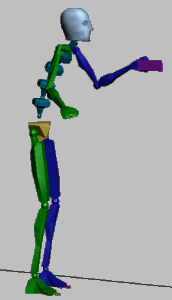
-
 Select your biped and on the
Select your biped and on the  Motion panel, expand the Layers rollout.
Motion panel, expand the Layers rollout. -
 Create a new layer and name it Low center of mass.
Create a new layer and name it Low center of mass. The
 (Retarget Left Arm) button in the Retargeting group becomes active, which indicates that the current layer honors the IK constraint of the base layer for this body part.
(Retarget Left Arm) button in the Retargeting group becomes active, which indicates that the current layer honors the IK constraint of the base layer for this body part. 
- Turn on
 Auto Key.
Auto Key. - On the Track Selection rollout, turn on
 (Body Vertical).
(Body Vertical). This selects the biped's center of mass.
-
 Lower the center of mass on the Z axis until the biped's head is under the base layer's head display (represented as a red box). Tip: To avoid deselecting the center of mass, you can lock it by clicking the
Lower the center of mass on the Z axis until the biped's head is under the base layer's head display (represented as a red box). Tip: To avoid deselecting the center of mass, you can lock it by clicking the (Selection Lock Toggle) (or press
(Selection Lock Toggle) (or press  ).
). The entire biped is lowered except its left hand, which remains locked to the object because the current layer retargets it to match the respective IK constraint of the base layer.
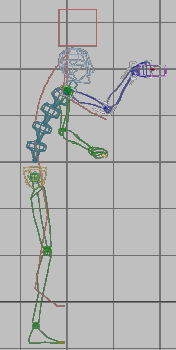
Only the biped's left hand constraint is honored.
- In the Retargeting group, turn on both
 (Retarget Left Leg) and
(Retarget Left Leg) and  (Retarget Right Leg). Then click Update.
(Retarget Right Leg). Then click Update. The biped's IK feet are adjusted to match those of the base layer. The animation keys are updated to reflect the current layer's retargeted feet.
Tip: If some body parts assume odd positions, simply drag the time slider a few frames past your current frame, and then drag it back home.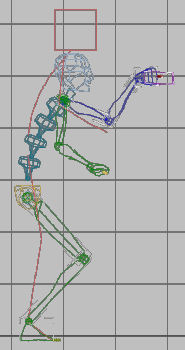
Both the biped's feet and left hand constraints are honored.
- You can continue animating the biped to your liking.
 Collapse your layers when you are satisfied.
Collapse your layers when you are satisfied.
This procedure takes into account the fundamentals of animating across layers and expands on the concept of honoring IK constraints.
Example: To maintain IK constraints from a reference biped:
- Prepare an animated biped or load a BIP file onto one.
- Create a second biped alongside and rename it Disproportionate Biped.
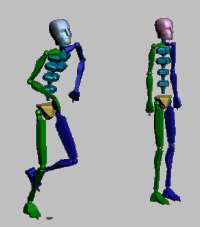
The animated biped on the left and Disproportionate Biped on the right
- Select Disproportionate Biped and enter
 (Figure Mode).
(Figure Mode). Now you can change the biped's structure.
- Scale its upper arms and thighs to make them disproportionate from the rest of its body. Tip: You can quickly select body parts on both sides of a biped if you first select the body part, then on the Track Selection rollout, click
 (Symmetrical).
(Symmetrical). 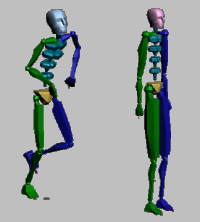
- Exit
 (Figure Mode).
(Figure Mode). - Keep Disproportionate Biped selected and expand the Layers rollout.
- Click
 (Select Reference Biped) and in a viewport, select your original biped.
(Select Reference Biped) and in a viewport, select your original biped. Disproportionate Biped adopts the animation from the reference biped, whose name is now displayed next to the
 (Select Reference Biped) button.
(Select Reference Biped) button. 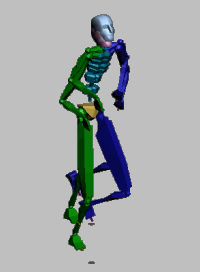
-
 Add a new layer and name it Retargeted Biped.
Add a new layer and name it Retargeted Biped. - Turn on both
 (Retarget Left Arm) and
(Retarget Left Arm) and  (Retarget Right Arm), and then click Update.
(Retarget Right Arm), and then click Update. Both hands precisely match those from the reference biped. The animation keys are updated to reflect the current layer's retargeted hands.
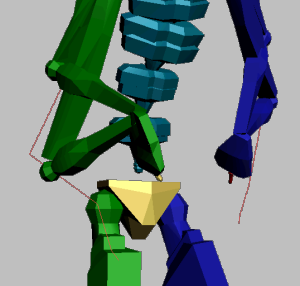
Both hands are retargeted to honor the base layer IK constraints.
- Turn on both
 (Retarget Left Leg) and
(Retarget Left Leg) and  (Retarget Right Leg). Then, click Update.
(Retarget Right Leg). Then, click Update. The feet are correctly retargeted to the reference biped, updating the respective animation keys.

The feet are retargeted to honor the base layer IK constraints.
- Use
 (Previous Layer) and
(Previous Layer) and  (Next Layer) to switch between the original and Retargeted Biped layers. The base layer displays the non-targeted motion while Retargeted Biped shows an adjusted motion that matches both hands and feet from Disproportionate Biped with the original biped.
(Next Layer) to switch between the original and Retargeted Biped layers. The base layer displays the non-targeted motion while Retargeted Biped shows an adjusted motion that matches both hands and feet from Disproportionate Biped with the original biped. - You can continue animating the biped to your liking.
 Collapse your layers when you are satisfied.
Collapse your layers when you are satisfied.
This procedure centers on using an animated biped as a retarget reference for another biped with disproportionate body parts. This method is often used when a motion is imported from raw data and adapted to bipeds with different proportions.
Interface
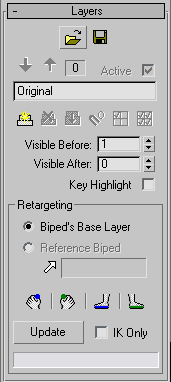
[Load and Save buttons]
You can load and save individual biped layers as BIP files.
-
 Load Layer
Load Layer - Click to display a Biped Open dialog and open a BIP file for the active layer.
3ds Max objects and list controllers are loaded only at the base layer (0). When you load into a higher layer, separate tracks are removed, and IK is removed for any limb.
If Retarget is on for a limb, the limb keys are removed. After you load a layer, retargetting does not happen automatically: you must click Update after you load the layer.
-
 Save Layer
Save Layer - Opens the Biped Save As dialog and save the current layer’s animation in a BIP file.
3ds Max objects are saved only at the base layer (0).
-

 Previous Layer / Next Layer
Previous Layer / Next Layer - Navigate through the layers by clicking the up and down arrows. The current layer number appears in the numeric field next to the arrow buttons. Note: 3ds Max plays animation for the selected biped only from the active layer and the active layers below it. So, for example, if the biped contains animation in four active layers—0, 1, 2, and 3—and the current layer is layer 2, playing the animation shows the animation in layers 0, 1, and 2, but not layer 3.
- [Layer Number]
- Displays the number of the current layer.
- Active
- Toggles the current layer. Unavailable for layer 0, which is always active.
- [name field]
- Type a name to easily identify a layer.
-
 Create Layer
Create Layer - Creates a layer above the current layer, and increments the Layer Number field.
Position the biped to create keys in a layer.
-
 Delete Layer
Delete Layer - Deletes the current layer.
All layer numbers above the one deleted are decremented by one.
-
 Collapse Layers
Collapse Layers - Combines the animation in the current layer into that in the next-lowest active layer and then deletes the current layer.
For instance, if layer 3 is the current layer and layer 2 is inactive, collapsing layer 3 moves its animation data into layer 1 and then deletes layer 3.
-
 Snap Set Key
Snap Set Key - Snaps the selected biped part to its original position in layer 0 and creates a key.
Use this in higher layers to return the selected biped part to the original motion. For example, if a layer has a posture key that bends the character forward at frame 2 and you want to return the biped to its original posture motion at frame 50, use Snap Set Key at frame 50 with a spine object selected. The character will interpolate from its forward posture position to its original posture position between frames 2 and 50.
-
 Activate Only Me
Activate Only Me - Enables viewing only the animation in the current layer and in layer 0.
-
 Activate All
Activate All - Activates all layers.
Playing the animation shows a composite of all the layers.
- Visible Before
- The number of preceding layers to display as stick figures.
- Visible After
- The number of succeeding layers to display as stick figures.
- Key Highlight
- Displays keys by highlighting the stick figures.
Retargeting Group
The tools in this group let you animate a biped across layers while maintaining the IK constraints of the base layer. You can also choose to use a different biped in your scene to use as reference for your biped's retargeted hands and feet.
- Biped's Base Layer
- Choose this method to use the IK constraints from the selected biped's original layer as retarget reference. Default=active.
- Reference Biped
- Choose this method to use the biped whose name is displayed next to the Select Reference Biped button as retarget reference.
-
 Select Reference Biped
Select Reference Biped - Lets you choose a biped to use as retarget reference for the selected biped. The chosen biped's name is displayed next to the button.
-
 Retarget Left Arm
Retarget Left Arm - When on, the IK constraints of the base layer are honored for the biped's left arm.
-
 Retarget Right Arm
Retarget Right Arm - When on, the IK constraints of the base layer are honored for the biped's right arm.
-
 Retarget Left Leg
Retarget Left Leg - When on, the IK constraints of the base layer are honored for the biped's left leg.
-
 Retarget Right Leg
Retarget Right Leg - When on, the IK constraints of the base layer are honored for the biped's right leg.
- Update
- Calculates the selected biped's hands and feet positions for every set key based on the retarget method (Base Layer or Reference Biped), the active retarget body parts buttons, and the IK Only option.
- IK Only
- When on, the biped's constrained hands and feet are retargeted only during the frames on which they are IK controlled. When off, the hands and feet are retargeted during both IK and FK keys. Default=off.